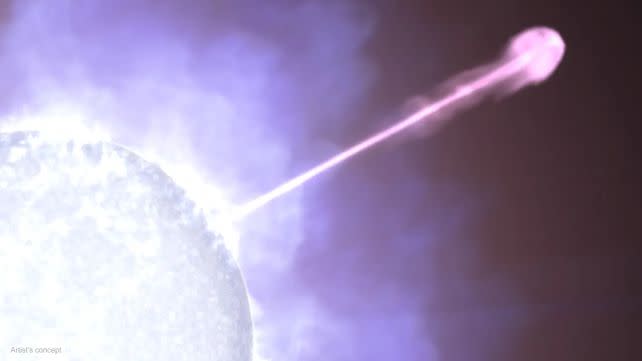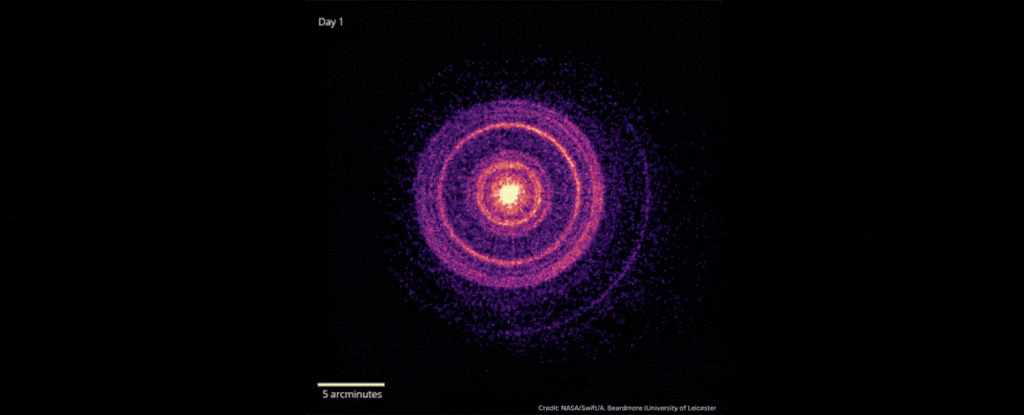Every now and again, the night sky lights up with a spectacular explosion that blazes with the most energetic light our Universe can produce. Known as gamma-ray bursts, they can release in a few seconds what our Sun will emit over its lifetime.
Now scientists have found a never-before-seen signal buried in the spectrum of electromagnetic radiation delivered by the brightest gamma ray burst ever recorded.
That signal is an emission light – a bright region in the gamma-ray spectrum produced by something emitting light in that specific wavelength range. And that something, scientists have determined, is complete and utter destruction: the mutual annihilation of electron-positron pairs, matter and its antimatter counterpart.
Nicknamed ‘the BOAT’ (short for the Brightest Of All Time), the burst was detected back in October of 2022. It was the result of a huge star exploding as its core collapsed into a black hole, spilling out so many energetic photons we had a hard time taking accurate measurements.
But measurements were, indeed, taken, and scientists knew from very early on that they were looking at something special.
“A few minutes after the BOAT erupted, Fermi’s Gamma-ray Burst Monitor recorded an unusual energy peak that caught our attention,” says astrophysicist Maria Edvige Ravasio of Radboud University in the Netherlands.
“When I first saw that signal, it gave me goosebumps. Our analysis since then shows it to be the first high-confidence emission line ever seen in 50 years of studying gamma-ray bursts.”
Appearing as brightened bars on the spectrum of light emitted from a source, emission lines indicate something is causing light of particular wavelengths to shine more brightly – a source of extra emission. Similarly, darker bars known as absorption lines can appear where wavelengths of light are absorbed.
Emission and absorption features can tell us a lot about the constituent chemistry of various astrophysical processes, from the metallicity of stars to molecules in the makeup of distant planetary atmospheres.
There are different scenarios that can produce a gamma-ray burst, an explosion of the most energetic light on the electromagnetic spectrum, but the one that produced the BOAT – officially named GRB 221009A – was the birth of a black hole. The outer material of the star was violently ejected out into space, while the core collapsed under gravity to form the densest kind of object in the Universe.

This explosion was accompanied by jets or particles bursting outwards in opposite directions. This is what we see in a gamma-ray burst, with the jet angled towards our line of sight.
When GRB 221009A first exploded, the brightness was so extreme it obscured any detail. Over 80 seconds, the burst evolved from a peak energy of 12 million electron volts down to around 6 million electron volts. Just five minutes later, the brightness had subsided enough for the Fermi gamma-ray telescope to discern an emission line that lasted for at least 40 seconds.
The researchers believe a phenomenon called annihilation was responsible for the enhanced glow. When an electron and its antimatter counterpart, a positron, collide, they produce a photon with an energy of 0.511 million electron volts.
The emission feature observed in the BOAT reflects a much higher energy, but the researchers have an explanation for that. The annihilation occurred in a jet that was moving towards us at roughly 99.9 percent of the speed of light. This made the energy appear much higher than it was, an illusion based on our viewing angle that can be seen in other astrophysical jets.
“Because we’re looking into the jet, where matter is moving at near light speed, this emission becomes greatly blueshifted and pushed toward much higher energies,” explains astrophysicist Gor Oganesyan of Gran Sasso Science Institute in Italy.
Although it seems like GRB 221009A was an extreme example of a gamma ray burst, subsequent observations and analysis have since revealed that the BOAT was actually quite normal – its brightness was merely the result of its orientation, erupting right in our direction.
This is actually good news. It means we can use the BOAT to understand how gamma-ray bursts typically evolve over time, and the processes that take place within them.
“After decades of studying these incredible cosmic explosions, we still don’t understand the details of how these jets work,” says astrophysicist Elizabeth Hays of NASA’s Goddard Space Flight Center.
“Finding clues like this remarkable emission line will help scientists investigate this extreme environment more deeply.”
The findings have been published in Science.
